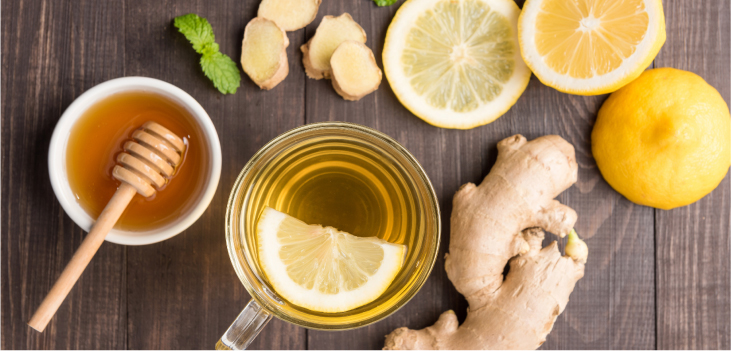Using Your Pantry to Boost your Immune System
Posted by in Uncategorized
Much of the northern hemisphere is smack in the middle of one of the most challenging times of year for maintaining good health. The winter season of colds, flu, infections and the spread of illness compels us retreat to the indoors. Dry heat, lack of fresh air, and the inevitable proximity to infected people can put us at a disadvantage. Fear not, as there are ample steps you can take to fend off these external threats and strengthen your immune system naturally. And (this should be of no surprise coming from me) the source is your kitchen pantry.
Despite the huge diversity of antimicrobial drugs, bacterial resistance to the antibiotic arsenal is increasing to the extent that the word “superbugs” is a household term. Consequently, research continues to explore the antimicrobial potential of many natural agents common to our diets. Incorporating these palate delights can not only raise our immune system potential but also assist it in its battle to fight infection.
So rather than wait to be sick, let’s head to the kitchen and start eating our way to healing, health and vitality.
Garlic
For centuries, garlic has been used to treat a number of ailments. As one of the oldest cultivated plants in the world, garlic has been grown for over 5000 years. Although garlic offers many health benefits, its antibacterial and antiviral aspects are perhaps its most legendary. In addition, garlic exhibits potent anti-inflammatory activity as well as having good antioxidant potential. Garlic can be used to enhance the flavor of any dish. Chopping or crushing the garlic clove stimulates the enzymatic process that converts the phytonutrient alliin to allicin, the compound to which garlic’s health benefits are attributed. Leaving the crushed or chopped garlic for 5 minutes also allows the greatest opportunity for the allicin to develop.
To reduce the effect of “garlic breath,” chew on fresh, organic parsley after the meal. Garlic can also be consumed in capsule form, making it easy to consume on a regular basis.
Ginger
Historically, the use of ginger has been associated with relieving gastrointestinal distress from nausea to intestinal spasms. However, gingerol, a phytonutrient present in ginger, is also a potent anti-inflammatory. Adding fresh ginger to a menu is simple and easy. Peel and slice fresh ginger root and add it to hot water. Sip it hot or cold all day long. Drinking ginger tea can help relieve the nausea and pain associated with the flu.
Manukah Honey
The use of honey to treat infection dates back to the Sumerians in 2000 B.C. Research on this common pantry item has demonstrated that the high sugar content of honey is capable of dehydrating bacterial cells. In addition, honey’s acidity can inhibit the growth and proliferation of many bacteria, while an enzyme (glucose oxidase) present in this sweetener reduces oxygen to hydrogen peroxide, a known antibacterial.
Manukah honey in particular is derived from the flower of the tea tree bush and is thought to be the most potent naturally occurring honey. It also seems to exhibit more antibacterial properties than standard honey.
Shiitake Mushrooms
Much interest has focused on the immune potential and antibacterial properties of mushrooms and their extracts. Among those studied is the shiitake species. Shiitake mushrooms have a long history of being appreciated as a pantry delicacy. They are frequently used to enhance the flavor and aroma of other foods. The interest in shiitake mushrooms has increased recently because of their high nutritional value and medicinal properties. Shiitake mushrooms have shown the potential to fight both Bacillus bacteria and Staphylococcus aureus bacteria. So the next time you head to the kitchen to make an omelet, soup, stew or stir fry, don’t forget to add the aroma- and flavor-enhancing antibacterial superfood, the shiitake mushroom.
Turmeric
Originally referred to as “Indian saffron,” turmeric has a long history in the kitchen as a condiment, in the medicine cabinet as a healing remedy and in the clothing industry as a textile dye. Curcumin, the yellowy-orange pigment of turmeric, has been used as a potent anti-inflammatory in both the Chinese and Indian systems of medicine. So potent are its anti-inflammatory properties that it has actually been shown in research to be as effective as hydrocortisone and ibuprofen. Unlike these drugs, which are associated with a significant, long-term side effect of toxicity, curcumin produces no toxicity. Inflammation is a typical symptom of infection, and turmeric offers a safe and effective alternative to both prescription and over-the-counter anti-inflammatory medications.
In addition to these foods, healthy lifestyle habits that boost your immunity include:
- Daily exercise
- Adequate hydration
- Enduring and productive sleep
- Daily relaxation and meditation
- Deep breathing and sufficient oxygen
- Nurturing relationships
- Stress reduction
These all have a remarkable impact on your immune system and your ability to prevent and fight infection.
Here’s a quick application of some of the elements I’ve touched upon in this blog. It’s a quick, yummy and potent concoction to nurture your day.
Lemon Manukah Honey and Ginger Hot Toddy
Ingredients
Juice of 1 whole lemon, regular or Meyer
1 tablespoon Manukah honey
Peeled, sliced fresh ginger root
½ teaspoon turmeric
Process
Mix all of the ingredients together.
Divide into three doses.
Combine each dose with 1-2 tablespoons of warm alkaline water.
Wishing you cheers and good health!
Be well now!
(Original post on boomspot)
You can follow any responses to this entry through the RSS 2.0 You can leave a response, or trackback.



Leave a Reply